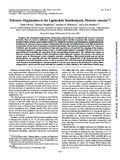Mostrar el registro sencillo del ítem
Telomere organization in the ligninolytic basidiomycete Pleurotus ostreatus
| dc.creator | Pérez Garrido, María Gumersinda | es_ES |
| dc.creator | Pangilinan, Jasmyn | es_ES |
| dc.creator | Pisabarro de Lucas, Gerardo | es_ES |
| dc.creator | Ramírez Nasto, Lucía | es_ES |
| dc.date.accessioned | 2019-01-10T08:27:54Z | |
| dc.date.available | 2019-01-10T08:27:54Z | |
| dc.date.issued | 2008 | |
| dc.identifier.issn | 0099-2240 (Print) | |
| dc.identifier.issn | 1098-5336 (Electronic) | |
| dc.identifier.uri | https://hdl.handle.net/2454/31938 | |
| dc.description.abstract | Telomeres are structural and functional chromosome regions that are essential for the cell cycle to proceed normally. They are, however, difficult to map genetically and to identify in genome-wide sequence programs because of their structure and repetitive nature. We studied the telomeric and subtelomeric organization in the basidiomycete Pleurotus ostreatus using a combination of molecular and bioinformatics tools that permitted us to determine 19 out of the 22 telomeres expected in this fungus. The telomeric repeating unit in P. ostreatus is TTAGGG, and the numbers of repetitions of this unit range between 25 and 150. The mapping of the telomere restriction fragments to linkage groups 6 and 7 revealed polymorphisms compatible with those observed by pulsed field gel electrophoresis separation of the corresponding chromosomes. The subtelomeric regions in Pleurotus contain genes similar to those described in other eukaryotic systems. The presence of a cluster of laccase genes in chromosome 6 and a bipartite structure containing a Het-related protein and an alcohol dehydrogenase are especially relevant; this bipartite structure is characteristic of the Pezizomycotina fungi Neurospora crassa and Aspergillus terreus. As far as we know, this is the first report describing the presence of such structures in basidiomycetes and the location of a laccase gene cluster in the subtelomeric region, where, among others, species-specific genes allowing the organism to adapt rapidly to the environment usually map. | en |
| dc.description.sponsorship | This work has been supported by funds from the AGL2005-08005- C02-01 and GEN2006-27843-E grants and by additional institutional support from the Public University of Navarre. | en |
| dc.format.extent | 10 p. | |
| dc.format.mimetype | application/pdf | en |
| dc.language.iso | eng | en |
| dc.publisher | American Society for Microbiology | en |
| dc.relation.ispartof | Applied and Environmental Microbiology, Mar. 2009, Vol. 75, No. 5, p. 1427–1436 | en |
| dc.rights | © 2009, American Society for Microbiology. All Rights Reserved. | en |
| dc.subject | Pleurotus ostreatus | en |
| dc.subject | Telomere organization | en |
| dc.title | Telomere organization in the ligninolytic basidiomycete Pleurotus ostreatus | en |
| dc.type | info:eu-repo/semantics/article | en |
| dc.type | Artículo / Artikulua | es |
| dc.contributor.department | Producción Agraria | es_ES |
| dc.contributor.department | Nekazaritza Ekoizpena | eu |
| dc.rights.accessRights | info:eu-repo/semantics/openAccess | en |
| dc.rights.accessRights | Acceso abierto / Sarbide irekia | es |
| dc.identifier.doi | 10.1128/aem.01889-08 | |
| dc.relation.publisherversion | https://doi.org/10.1128/aem.01889-08 | |
| dc.type.version | info:eu-repo/semantics/publishedVersion | en |
| dc.type.version | Versión publicada / Argitaratu den bertsioa | es |
| dc.contributor.funder | Universidad Pública de Navarra / Nafarroako Unibertsitate Publikoa | es |


